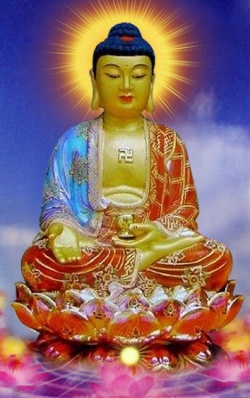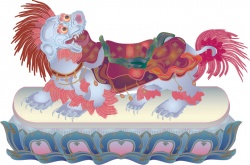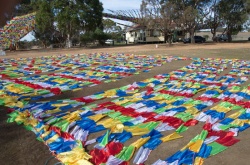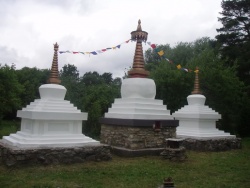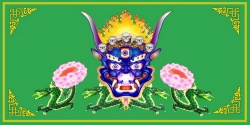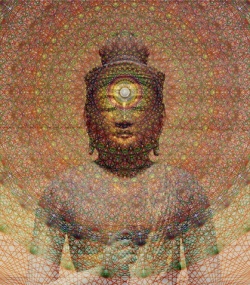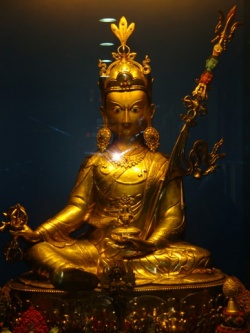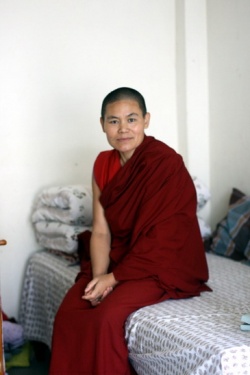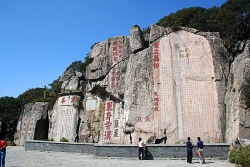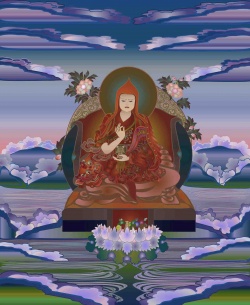Yogācāra
- See also :
- See also :
Yogacara ("practice of yoga]]") is a philosophical branch of Mahayana Buddhism that emerged in India in the 4th century CE. Its influence is still evident today in many schools of Buddhism, including Tibetan, Zen, and Shingon.
Yogacara is also known as Vijanavada, or the School of Vijnana because Yogacara is primarily concerned with the nature of Vijnana and the nature of experience. Vijnana is one of the three kinds of mind discussed in early Buddhist scriptures such as the Sutta-Pitaka. Vijnana often is translated into English as "awareness," "consciousness" or "knowing." It is the fifth of the Five Skandhas .
Origins of Yogacara
Although some aspects of its origins are lost, British historian Damien Keown says that early Yogacara very probably was linked to the Gandhara branch of an early Buddhist sect called Sarvastivada. The founders were monks named Asanga, Vasubandhu, and Maitreyanatha, who are all thought to have had some connection to Sarvastivada before they converted to Mahayana.
These founders saw Yogacara as a corrective to the Madhyamika philosophy developed by Nagarjuna, probably in the 2nd century CE. They believed Madhyamika leaned too closely to nihilism by over-emphasizing the emptiness of phenomena, although no doubt Nagarjuna would have disagreed.
Adherents of Madhyamika accused the Yogacarins of substantialism or a belief that some kind of substantial reality underlies phenomena, although this criticism doesn't seem to describe actual Yogacara teaching.
For a time, the the Yogacara and Madhyamika philosophical schools were rivals. In the 8th century, a modified form of Yogacara merged with a modified form of Madhyamika, and this combined philosophy makes up a large part of the foundations of Mahayana today.
Basic Yogacara Teachings
Yogacara is not an easy philosophy to understand. Its scholars developed sophisticated models explaining how awareness and experience intersect. These models describe in detail how beings experience the world.
As has already been said, Yogacara is primarily concerned with the nature of vijnana and the nature of experience. In this context, we can think of vijnana is a reaction that has one of the six faculties (eye, ear, nose, tongue, body, mind) as its basis and one of the six corresponding phenomena (visible object, sound, smell taste, tangible
object, though) as its object. For example, visual consciousness or vijnana -- seeing -- has the eye as its basis and a visible phenomenon as its object. Mental consciousness has the mind ( manas) as its basis and an idea or thought as its object. Vijnana is the awareness that intersects faculty and phenomenon.
To these six types of vijnana, Yogacara added two more. The seventh vijnana is deluded awareness or klista-manas. This kind of awareness is about self-centered thinking that gives rise to selfish thoughts and arrogance. The belief in a separate, permanent self arises from this seventh vijnana.
The eighth consciousness, alaya-vijnana, is sometimes called "storehouse consciousness." This vijnana contains all the impressions of previous experiences, which become the seeds of karma.
Very simply, Yogacara teaches that vijnana is real, but objects of awareness are unreal. What we think of as external objects are creations of consciousness. For this reason, Yogacara is sometimes called the "mind only" school.
How does this work? All unenlightened experience is created by the various kinds of vijnana, which generate the experience of an individual, permanent self and project delusional objects onto reality. Upon enlightenment, these dualistic modes of awareness are transformed, and the resulting awarenesses are able to perceive reality clearly and directly.
Yogacara in Practice
The "yoga" in this case is a meditation yoga which was central to practice. Yogacara also emphasized the practice of the Six Perfections.
Yogacara students went through four stages of development. In the first, the student studied the Yogacara teachings to get a good grasp of them. In the second, the student moves beyond concepts and engages in the ten stages of development of a
bodhisattva, called bhumi. In the third, the student finishes passing through the ten stages and begins to liberate himself from defilements. In the fourth, defilements have been eliminated, and the student realizes enlightenment
The Yogācāra school is, with the Mādhyamika, one of the two main traditions of Indian Buddhism. As the name indicates (yogācāra means "one whose practice is yoga"), this school attaches importance to the religious practice of yoga as a means for attaining final emancipation from the bondage of the phenomenal world. The stages of yoga are systematically set forth in the treatises associated
with this tradition. The particular doctrinal stance of the school is suggested by its alternate name, Vijñānavāda, or the "doctrine" (vāda) that all phenomenal existence is fabricated by "consciousness" (vijñāna).
In concert with those who uphold the doctrine of "voidness" (śūnyatā), the Vijñānavādins maintain that phenomenal existences are devoid of intrinsic nature, but unlike the Mādhyamika, they admit the reality of the consciousness by which phenomenal existences,
subjective as well as objective, are fabricated. This consciousness, however, is not deemed to exist in the ultimate sense. It subsists for but a moment and is replaced by the consciousness in the next moment.
It has no substantiality and its origination is dependent on the consciousness of the preceding instant. To use the Yogācāra terminology, consciousness is of dependent nature (paratantra-svabhāva) and, as such, is not ultimately real. The Prajñāpāramitā Sūtras teach the
voidness, or the nonexistence, of all entities. However, it is a fact of experience that phenomenal existences appear as if they were real. By admitting the reality of the consciousness, the Yogācāra clarified the foundation of our daily experience.
According to the Saṃdhinirmocana Sūtra, a Yogācāra text, the Buddha set the "wheel of the doctrine" (dharmacakra) in motion three times. On the first turning, the Buddha taught the doctrine of the four noble truths (catvāry āryasatyāni), the Hīnayāna path culminating in arhatship; on the second, he taught the doctrine of universal voidness designed to advance
practitioners along the path to Buddhahood. But because the complete meaning of the Buddha's teaching was not fully elucidated during these "turnings," the Buddha set the wheel in motion a third time, with the intention of making explicit (nītārtha) what was only implicit (neyārtha) in the sūtras composed in earlier times.
Formative Period
The Yogācāra philosophy was systematized by Asaṅga and Vasubandhu, thinkers who lived in the fourth or fifth century. However, some important Yogācāra works, namely, the Saṃdhinirmocana Sūtra, the Yogācārabhūmi,and the treatises ascribed to Maitreya(nātha), predate them.
The Saṃdhinirmocana Sūtra's major contribution to the Yogācāra school is its formulation of the doctrine of the three "characteristics" (lakṣaṇa) of entities: the imaginary character (parikalpita-lakṣaṇa), the dependent character (paratantra-lakṣaṇa), and the
perfected character (pariniṣpanna-lakṣaṇa). (All are explained in chapter 6.) The imaginary character is the assignation of conventional names to things with respect to their intrinsic nature (svabhāva) and specific qualities (viśeṣa).
The dependent character is the conditioned origination (Pratītya-samutpāda) of things. The perfected character is the "thusness" (tathatā) of things or the emptiness of intrinsic nature in things. These three characteristics are closely related to the "triple
unreality" discussed in chapter 7. Since the characteristic features of things are established merely by the act of assigning them conventional names, these features are ultimately unreal. Thus, the imaginary character of things is related to the unreality of their characteristic features (lakṣaṇa-niḥsvabhāvatā). Since the origination of things is dependent on causes and conditions,
it is also not real. Thus the dependent character is related to the unreality of origination (utpatti-niḥsvabhāvatā). The ultimate reality is manifested through the thusness of things or the emptiness of intrinsic nature in things. Thus, the perfected character is related to the unreality of intrinsic nature, which is the ultimate reality (paramārtha-niḥsvabhāvatā).
The doctrine of three characteristics and triple unreality expresses what the Buddha had in mind when, in the Prajñāpāramitā Sūtras, he taught that all entities are devoid of intrinsic nature. It is understood that the Prajñāpāramitā Sūtras put forth a teaching,
the meaning of which is inexplicit and must be drawn out (neyārtha). The Saṃdhinirmocana Sūtra unfolds (nirmocana) the "intention" (saṃdahi) of the Buddha that was hidden in the doctrine of voidness. This purpose is brought to full expression through the doctrine of triple unreality. Thus, this sūtra is of explicit meaning (nītārtha).
Chapter 5 of the Saṃdhinirmocana Sūtra presents the concept of ālaya-vijñāna ("storehouse consciousness"), which is characteristic of the Yogācāra teachings. It describes this consciousness as possessing "all the seeds" (sarvabījaka) from which future phenomenal existences will grow. The storehouse consciousness is attached to the sense faculties and to the
impressions of "differentiations" (prapañca) left by the conventional usages regarding phenomenal existences and is called "attachment consciousness" (ādāna-vijñāna). Chapter 9 gives a detailed explanation of the practices of
tranquilization (śamatha) and contemplation (vipaśyanā) through which a practitioner acquires the ability to concentrate his mind on certain ideas and to visualize and efface them at will. This practice forms the basis of the Yogācāra view that there is no external object.
The Yogācārabhūmi (Stages of the follower of yoga practice) is a voluminous, comprehensive work comprising five parts. The main part, which is called "Basic Text of the Stages," treats the seventeen stages (bhūmi) to be successively passed through by a follower of yoga practice. It
begins with the stage of sense perceptions, proceeds through many stages of meditation and other practices, reaches the stage of "disciples" (śrāvaka), then of "isolated Buddhas" (pratyekabuddha), then of bodhisattvas, and ends with the stage of complete nirvāṇa (nirupadhiśeṣa-nirvāṇa, or "nirvāṇa with no residue"), the ultimate goal.
The Buddhist tradition in China attributes this work to Maitreya, but in Tibet it is known as a work of Asaṅga. Regarding the composition of a treatise dealing with seventeen stages, Paramārtha's Life of Vasubandhu (T.D. no. 2049) and Xuanzang's Da Tang xiyu ji
(T.D. no. 2087) provide the following account. Asaṅga often went up to the Tuṣita Heaven, where he was taught the Mahāyāna doctrines by the bodhisattva Maitreya. Complying with the request of Asaṅga, who wanted Mahāyāna Buddhism to spread among the people, Maitreya came down to the continent of Jambudvīpa and gave a series of lectures on the seventeen stages.
He lectured every night for four months; the next day Asaṅga, for the sake of the other attendants, gave a full explanation of what the bodhisattva had taught. (Asaṅga was the only attendant who had access to the bodhisattva; the others could merely hear him from afar.) This account may explain why the Chinese and the Tibetan traditions differ on the authorship of the Yogācārabhūmi. Some scholars assume
that Maitreya, from whom Asaṅga is said to have received instruction on the Yogācāra doctrine, was a historical person; others, however, debate Maitreya's historicity. Recent studies of the Yogācārabhūmi have proved that it was not the work of a single person; it is now supposed that the text was gradually enlarged by successive generations of Yogācāra scholars.
The Yogācārabhūmi enumerates, classifies, and explains all elements that relate to the practice of each of the seventeen stages in the same manner as that of Abhidharma treatises. The doctrine of ālaya-vijñāna is found in the first two chapters of the "Basic Text" and in some
sections of the "Compendium of Ascertainment" (an auxiliary division), while the doctrine of the three characteristics of entities is mentioned only in the latter division. The chapter dealing with the "stage of bodhisattvas" (bodhisattvabhūmi) is devoted to the detailed analysis of the religious practices of bodhisattvas, systematically explaining the matters with which their practices are concerned, the
ways that their practices are to be conducted, and the results to be attained by the practices. It is known that this chapter once existed as an independent text.
In the Tibetan Buddhist tradition the following five works are ascribed to Maitreya(nātha): Mahāyānasū-trālaṃkāra, Madhyāntavibhāga, Dharmadharmatāvibhaṅga, Ratnagotravibhāga, and Abhisamayālaṃkāra. The last two are not considered Yogācāra works.
The Mahāyānasūtrālaṃkāra (Ornament of Mahāyāna Sūtras), which presents a systematic exposition of the practices of bodhisattvas, consists of about 800 verses and is divided into 21 chapters. According to the Tibetan tradition, the verse text was written by Maitreyanātha and the prose commentary by Vasubandhu; the Chinese tradition assigns both to Asaṅga. This treatise has the same structure as the
chapter in the Yogācārabhūmi dealing with the stage of bodhisattvas (bodhisattvabhūmi). The subject matter of chief concern to bodhisattvas—ultimate reality—is expounded in chapter 6, and the state of having attained the ultimate reality—enlightenment (bodhi)—is elucidated in chapter 9.
The theoretical basis of the practices of bodhisattvas is given in chapter 11. The Madhyāntavibhāga (Discrimination of the middle and the extremes), which gives the Yogācāra interpretation of the doctrine of voidness (śūnyatā), consists of about 110
verses and is divided into 5 chapters. Both the Chinese and the Tibetan traditions ascribe the verse text to Maitreya and the prose commentary to Vasubandhu. This treatise places voidness in the middle (madhya) of the two extremes (anta), that is, existence and nonexistence.
The Dharmadharmatāvibhaṅga (Discrimination of phenomenal existence and ultimate reality), a short treatise written in concise sūtra style, is commented upon by Vasubandhu. It was not transmitted to China. It shows that phenomenal existences, which are
characterized by the duality of subject and object or of denoter and denoted, are in reality modifications of a conscious principle called "unreal imagination" (abhūta-parikalpa). Through the cognition of the true nature of phenomenal existences, the ultimate reality—the "thusness" (tathatā) that is free from the duality—is realized.
These works, attributed to Maitreya, describe the ultimate reality with such positive terms as "sphere of religion" (dharmadhātu), instead of characterizing it merely as "void" or "empty" (śūnya). Like space, ultimate reality is all-pervasive, and there is no
phenomenal existence independent of it. It is also called the "essence of phenomenal existences" (dharmatā). The idea that the mind (citta) is essentially pure (prakṛti-viśuddha) and brilliant (prabhāsvara), a stance neglected in the dogmatics of the Abhidharma treatises, is fully supported, and the ultimate reality is identified with this pure and brilliant mind.
Whereas the concept of ālaya-vijñāna is not found in these works, the concept of "unreal imagination" (abhūta-parikalpa) plays an important role. The opening verse of the Madhyāntavibhāga clearly states that in emptiness (śūnyatā) there exists the unreal
imagination. However, the unreal imagination is not admitted to exist in the ultimate sense. It is essentially "unreal," but it is supposed to exist as the basis of the wrong assumption of the reality of phenomenal existences, which are characterized by the duality of subject and object, denoter and denoted, and so on.
Much importance is attached to the doctrine of the three characteristics (lakṣaṇa) or natures (svabhāva) of entities. In chapter 3 of the Madhyāntavibhāga this doctrine is considered the fundamental truth (mūlatattva), and some important doctrines, such as that of the
four noble truths, the two truths (ultimate and conventional), and so on, are elucidated in terms of the three natures. The stages of yogic practice (yogabhūmi) through which a practitioner is led to the "
transformation of the basis of his existence" (āśraya-parāvṛtti) and attains the ultimate reality, are explained systematically in chapter 11 of the Mahāyānasūtrālaṃkāra.
Period of Systematization
Asaṅga and Vasubandhu are the most prominent figures in the history of the Yogācāra school. Asaṅga first belonged to the Mahīśāsaka school of Hīnayāna Buddhism, but later, under the influence of the bodhisattva Maitreya, he became an advocate of the Mahāyāna. His treatises combine Abhidharmic analysis of the elements constituting phenomenal existences with Mahāyāna ideas. He composed, among
others, the Mahāyānasaṃgraha (Compendium of the Mahāyāna), a comprehensive work on Yogācāra doctrines and practices. In the first two chapters of this work he gives a full treatment of the doctrines of ālaya-vijñāna and of the three natures (trisvabhāva) of entities, thus laying the firm foundation of the philosophical system of the Yogācāra school.
According to Paramārtha's Life of Vasubandhu, Vasubandhu was a younger brother of Asaṅga. He wrote two Yogācāra treatises: the Viṃśatikā (Treatise of twenty verses) and the Triṃśikā (Treatise of thirty verses). The Viṃśatikā repudiates the realist view that the
image of an object in the consciousness has a corresponding reality in the external world and demonstrates that the image of an object appears in the consciousness as the result of a particular change (pariṇāma-viśeṣa) that occurs in the stream of the successive moments (saṃtati) of consciousness.
The Triṃśikā presents a lucid, concise exposition of Yogācāra dogmatics. The first half of this treatise analyzes the structure and the function of consciousness; the second elucidates the three-nature doctrine and the stages of practice. Regarded as the standard
textbook of the Yogācāra school, the Triṃśikā has been the subject of many commentaries by post-Vasubandhu scholars. Vasubandhu also composed a short treatise in verse dealing with the three-nature doctrine, the Trisvabhāvanirdeśa.
A number of other Yogācāra works have been handed down under the name of Vasubandhu, such as commentaries on the treatises attributed to Maitreya, on the Mahāyānasaṃgraha of Asaṅga, and on some Mahāyāna sūtras. The philosophical ideas expressed in these commentaries
are not identical with those presented in the Viṃśatikā and the Triṃśikā. In the last two works, the influence of the Sautrāntika school of Hīnayāna Buddhism is noticeable, but this is not the case with the commentaries. Accordingly, some modern scholars
believe that there were two Vasubandhus: one, Asaṅga's brother, composed the commentaries on sūtras and treatises; the other, the author of the
Viṃśatikā and the Triṃśikā, also wrote the Abhidharmakośa, a summary of Sarvāstivāda dogmatics, and an autocommentary written from the Sautrāntika viewpoint. However, further investigations must be made before a more definite conclusion can be drawn. The fundamental doctrines of the Yogācāra school as formulated by Asaṅga and Vasubandhu are surveyed below.
Representation only (vijñaptimātra)
The Yogācāras maintain that phenomenal existences, which are generally supposed to have objective reality in the external world, are no other than the "representations" (vijñapti), or images, of objects appearing in our consciousness (vijñāna). According to the Yogācāras, the image of an object is produced by the consciousness itself; there is no external object independent of the consciousness.
The Mahāyānasaṃgraha indicates that the image of an object in the consciousness does not presuppose the existence of the object in the external world. Some of the reasons mentioned are as follows;
1. The one and the same thing is represented differently by beings in different states of existence; for instance, that which is perceived by a man as a stream of clean water is represented as a flaming river by an inhabitant of hell and as a stream of pus and filth by a preta. This shows that an object represented in the consciousness is a product of mental construction.
2. It is a fact of experience that a cognition arises even when there is no object, as in the case of a recollection or dream. It is also known that a person who has advanced in yoga practice perceives a future object.
3. Through the practice of meditation (dhyāna) or tranquilization of the mind (śamatha), man comes to acquire the ability to visualize an object at will.
4. A practitioner who has stepped into the "path of insight" (darśana-mārga) attains "supermundane cognition" (lokottara-jñāna), in which there is no image of an object. This cognition, which has no corresponding reality in the external world, is thus experienced in daily life as well as in the process of religious practice.
Consequently, it is known that the form of an object that appears in the consciousness does not belong to a thing in the external world but is attributed to the consciousness itself.
Modification of consciousness (vijñāna-pariṇāma)
The Yogācāra maintains that human beings and objective things, to which various terms—such as "self" (ātman), "living being" (jīva), "pot," and "cloth"—are applied, are in reality the "modifications of consciousness." The consciousness that undergoes modification consists of three strata:
(1) the six kinds of consciousness produced through the visual, auditory, olfactory, gustatory, and tactile senses and the mind;
(2) the "I-consciousness," called manas, which accompanies the six kinds of consciousness; and
(3) the subliminal consciousness, called ālaya-vijñāna ("store consciousness"), in which the "impressions" (vasana) of past experiences are accumulated as the "seeds" (bija) of future experiences.
While the ālaya-vijñāna is latent, the six kinds of consciousness and the I-consciousness are in manifest activity and are thus called the "consciousness-in-activity" (pravṛtti-vijñāna). The ālaya-vijñāna and the consciousness-in-activity are dependent on each other: the
latter is produced from the seed preserved in the former and leaves, in turn, its impression on the former. Thus the modification (pariṇāma), or "change," of consciousness takes place in two ways:
(1) a seed planted by the consciousness-in-activity becomes ripe in the ālaya-vijñāna; and
(2) the consciousness-in-activity arises from the seed.
The term "modification" was first used by Vasubandhu, but the idea of the mutual dependence of the ālaya-vijñāna and the consciousness-in-activity was formulated by Asaṅga in the Mahāyānasaṃgraha.
The ālaya-vijñāna subsists only for a moment, then is replaced by another consciousness in the next moment. The successive moments of the ālaya-vijñāna form a stream that continues to flow until the seeds planted in it are completely destroyed. In each moment there arises the consciousness-in-activity, and thus a consciousness complex is formed. A human being is a stream of the consciousness complex, and the things that are thought to exist in the external world are but the images that appear in this stream of consciousness.
Three natures (trisvabhāva)
The three natures of entities, that is, the imagined nature (parikalpita-svabhāva), the dependent nature (paratantra-svabhāva), and the perfected nature (pariniṣpanna-svabhāva), were expounded in the Saṃdhinirmocana Sūtra, but this text does not discuss the interrelation of the three natures and
consequently the doctrine's religious significance is not quite clear. In the Mahāyānasaṃgraha, in which the three-nature doctrine is a major topic, Asaṅga sets forth the view that the imagined and the perfected natures are two aspects of the dependent nature; the dependent nature, he explains, appears as the imagined nature by dint of a false imagination and as the perfected nature when the false imagination is removed.
It is thus shown that the three-nature doctrine is closely related to Yogācāra soteriology. The doctrine, as formulated by Asaṅga and Vasubandhu, may be briefly summarized as follows. The consciousness that arises in each moment with the image of an object is of dependent nature because its origination is dependent on the impressions of past experiences preserved in the ālaya-vijñāna.
Because of his false imagination, man ordinarily takes this image for a real object and applies a name to it. The object thus superimposed upon the image in the consciousness is of imagined nature. When the false imagination is completely removed through the practice of yoga, man realizes the absence of the superimposed object, that is, the perfected nature.
Transformation of The Basis (Āśraya-ParāvṚtti)
The stages of yogic practice leading to the "transformation of the basis of existence" are systematized in some early Yogācāra works, and no substantial changes were made by Asaṅga and Vasubandhu. After passing the stage of accumulating merits and learning the Buddha's teaching, a yogācāra proceeds to the stage of "preparatory exercise" (prayoga). Through this stage he comes to understand clearly that
a name or a concept has no corresponding reality in the external world and that the intrinsic nature and specific qualities of things are products of subjective construction.
Thus, he realizes that there is no real object to be "seized" (grāhya) and, consequently, that the consciousness as the "seizer" (grāhaka) is also devoid of reality. At this moment he steps forward into the "path of insight" (darśana-mārga) and attains the immediate awareness of the ultimate reality. There arises in him the force to destroy the seeds of defilement that have accumulated
from beginningless time in the ālaya-vijñāna. This force gradually becomes more powerful as he proceeds to the "path of intensive practice" (bhāvanā-mārga). Finally, the seeds are completely destroyed and the stream of the ālaya-vijñāna no longer constitutes
the basis (āśraya) of his existence. In its place the ultimate reality reveals itself as the real, undifferentiated basis of all living beings. Through this transformation of the basis (āśraya-parāvṛtti) the yogācāra reaches the final stage of his yogic practice and attains Buddhahood.
Later Period: Transmission Into China And Japan
After Vasubandhu, scholars in the Yogācāra school formed two subschools. One maintained that the consciousness (vijñāna) is necessarily endowed with the "form" (ākāra) of an object and that of a subject; the other held that the forms of object and subject are of imagined nature and false and that the consciousness itself, which is a pure luminosity, is real. Proponents of the former were called,
from the eighth century onward, the Sākāra-vijñānavādins (that is, the upholders of the doctrine that the consciousness is endowed with forms) and proponents of the latter were termed the Nirākāra-vijñānavādins (that is, the upholders of the doctrine that the consciousness possesses no form).
Dignāga (c. 480–540) and Dharmapāla (c. 530–561), prominent scholars in Nālandā, are recognized as the early representatives of the former and Sthiramati (c. 510–570) in Valabhī as an advocate of the latter. The Sākāra-vijñānavāda is doctrinally related to the Sautrāntika school, and a branch of the Nirākāra-vijñānavāda, represented by Śāntirakṣita (c. 725–788) and Kamalaśīla (c. 740–795), is
united with the Mādhyamika. Scholarly activities continued in both subschools until the twelfth century, when Buddhism declined in India. In the last period, Ratnakīrti and Jñānaśrīmitra (eleventh century) maintained the former, and Ratnākārasanti (c. eleventh century) was a powerful advocate of the latter. Dharmakīrti (c. 600–660) and Prajñākāragupta (c. eighth century) are recognized by both subschools as exponents of their respective doctrines.
As early as the fifth century some Yogācāra works were translated into Chinese, but a real interest in Yogācāra was not aroused until Bodhiruci (?–527) arrived in China in 508 and translated Vasubandhu's commentary on the Daśabhūmika Sūtra, the Shi di jing lun (T.D. no. 1522), in which the doctrine of the ālaya-vijñāna is presented. This work was accepted as an authority among Buddhist circles in
North China, and gave rise to the Dilun sect. In the meantime, Paramārtha (c. 499–569), who came to South China in 546, introduced several Yogācāra treatises to the Buddhist circles.
He attached importance to the Mahāyānasaṃgraha, and his translation of this treatise, namely, the She dasheng lun (T.D. no. 1593), was treated as the basic text of the Shelun sect. In the seventh century, Xuanzang (602–664) traveled to India and studied Yogācāra doctrines
at Nālandā under Śīlabhadra, a disciple of Dharmapāla. After returning to China in 645, Xuanzang translated a number of important Yogācāra works. In his translation of Dharmapāla's commentary on the Triṃśikā Vijñaptimātratāsiddhiḥ of Vasubandhu, he incorporated the views of ten other commentators and composed the Cheng weishi lun. This work was recognized as authoritative for Yogācāra dogmatics by the
Faxiang sect, which was founded by Kuiji (632–682), a disciple of Xuanzang. Both the Dilun sect and the Shelun sect were absorbed into and replaced by the Faxiang sect, which itself soon declined under the new trend of Buddhism represented by the Huayan and Chan sects.
The dogmatics of the Faxiang (Jpn., Hossō) sect were introduced into Japan during the Nara period (710–784) by some monks who had studied in China. The Cheng weishi lun was earnestly studied there by Buddhist scholars of different sects until recent years.
Bibliography
- Frauwallner, Erich. Die Philosophie des Buddhismus. 3d rev. ed. Berlin, 1969. The philosophical ideas presented in the Yogācāra works of the early period and maintained by the principal figures of the Yogācāra school are clearly explained. Some passages extracted from important treatises are translated into German on pages 264–407.
- Fukaura Seibun. Yuishikigaku kenkyū. Kyoto, 1976. The dogmatics of the Faxiang sect are explained in detail.
- Hamamya Noriaki. Yuishiki-shisō Ronkō (Studies in philosophical ideas of the Vijñānavā). Tokyo, 2001. Collection of articles discussing some textual problems and philosophical ideas found in the Vijñānavā treatises.
- Hirakawa Akira. Indo bukkyōshi, vol. 2. Tokyo, 1979. A brief description of the Yogācāra teachers and their works and an exposition of the fundamental doctrines are given on pages 92–169, 228–250.
- Jacobi, Hermann, trans. Triṃśikāvijñapti des Vasubandhu, mit bhāṣya des acarya Sthiramati. Stuttgart, 1932.
- Lamotte, Étienne. Saṃdhinirmocana Sūtra: L'explication des mystères. Louvain, 1935.
- Lamotte, Étienne. La somme du Grand Véhicule d'Asaṅga (Mahāyānasaṃgraha). 2 vols. Louvain, 1938–1939.
- La Vallée Poussin, Louis de. Vijñaptimātratāsiddhi, la siddhi de Hiuan-tsang. 2 vols. Paris, 1928–1929.
- Lévi, Sylvain. Un système de philosophie bouddhique: Materiaux pour l'étude du système Vijñaptimātra. Paris, 1932.
- Lévi, Sylvain, ed. and trans.Asaṅga: Mahāyāna-sūtralaṃkāra, vol. 2, Exposé de la doctrine du Grand Véhicule selon le système Yogācāra. Paris, 1911.
- May, Jacques. "La philosophie bouddhique idéaliste." Asiatische Studien 25 (1971): 265–323. A sketch of the historical development of the Yogācāra school in India; elucidates the fundamental doctrines.
- Nagao Gadjin. Chūkan to yuishiki. Tokyo, 1978. Contains articles discussing some philosophical ideas of the Vijñānavāda.
- Nagao Gadjin. Mādhyamika and Yogācāra: A Study of Mahāyana Philosophies. Edited, collated, and translated by L. S. Kawamura in collaboration with G. M. Nagao. Albany, 1991. English versions of some articles published in Chūkan to yuishiki are included.
- Nagao Gadjin. Shōdai jōron. Wayaku to chūkai. (Mahāyānasaṃgraha. A Japanese translation with annotations.) 2 vols. Tokyo, 1982–87. A translation based on the comparison of all available texts in Chinese and Tibetan—Tibetan text and reconstructed Sanskrit text (Introd., chaps. I. II) are added as an appendix.
- Nagao Gadjin, Kajiyama Yūichi, and Aramaki Noritoshi. Seshin ronshū. Tokyo, 1976. Vasubandhu's Viṃśatikā, Triṃśikā (with Sthiramati's commentary), and Trisvabhāvanirdeśa, and Maitreya's Madhyāntavibhāga (with Vasubandhu's commentary) are translated into lucid modern Japanese.
- Powers, John, trans. Two Commentaries on the Saṃdhinir-mocana-sūtra by Asaṅga and Jñānagarbha. Lewiston, 1992.
- Sakuma Hidenori. Die Āśrayaparivṛtti-Theorie in der Yogācārabhūmi. 2 Stuttgart, 1990.
- Schmithausen, Lambert. Der Nirvāṇa-Abschnitt in der Viniścayasaṃgrahani der Yogācārabhūmih. Vienna, 1969.
- Schmithausen, Lambert. "Zur Literaturgeschichte der álteren Yogācāra-Schule." Zeitschrift der Deutschen Morgenländischen Gesellschaft; Supplement 1 (1969): 811–823. A careful examination of the composition of the Yogācārabhūmi.
- Schmithausen, Lambert. Ālayavijñāna. On the Origin and Early Development of a Central Concept of Yogācāra Philosophy. 2 Pts. Tokyo, 1987.
- Stcherbatsky, Theodore, trans. Madhyanta-vibhaṅga: Discourse on Discrimination between Middle and Extremes, Ascribed to Maitreyanātha and Commented by Vasubandhu and Sthiramati. Moscow, 1936.
- Suguro Shinjō. Shoki Yuishiki-shisō no kenkyū. Tokyo, 1989.
- Yamaguchi Susumu. Bukkyō ni okeru mu to u to no tairon. Kyoto, 1941. A detailed study of a chapter of Bhāvaviveka's Madhyamakahṛdaya, intended for the refutation of the Yogācāra doctrine.
- Yamaguchi Susumu, and Nozawa Jōshō. Seshin yuishiki no genten kaimei. Kyoto, 1953. Contains a Japanese translation of the Viṃśatikā with Vinītadeva's ṭīkā and the Triṃśikā with Sthiramati's bhāṣya and Vinitadeva's ṭīkā.
Source
By Hattori Masaaki
www.academicroom.com

